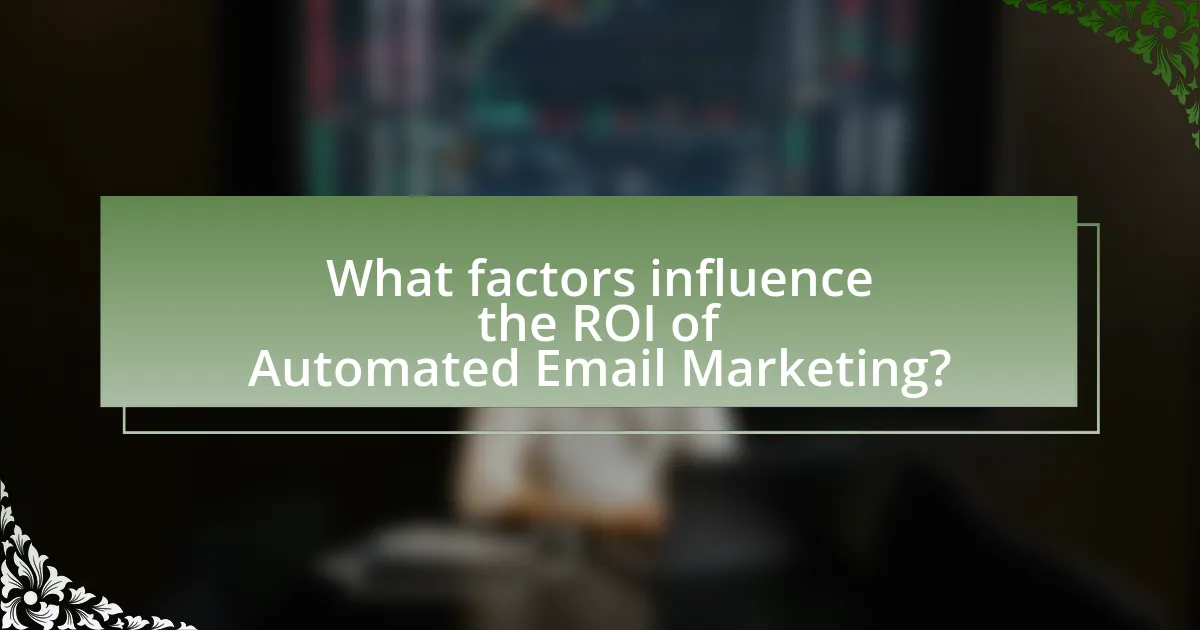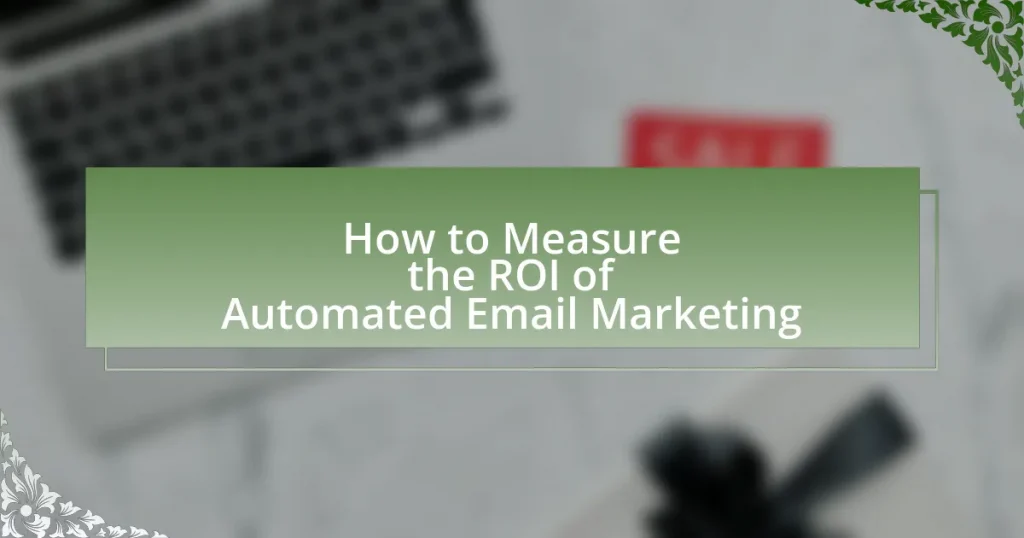The article focuses on measuring the return on investment (ROI) of automated email marketing, highlighting its average ROI of 4,200%, which translates to $42 earned for every dollar spent. It defines ROI in the context of email marketing, discusses key metrics such as open rates, click-through rates, and conversion rates, and emphasizes the importance of audience segmentation and personalized content in enhancing engagement and profitability. Additionally, the article outlines best practices for optimizing email campaigns, including A/B testing and analyzing performance metrics, to ensure effective resource allocation and continuous improvement in marketing strategies.

What is the ROI of Automated Email Marketing?
The ROI of Automated Email Marketing typically averages around 4,200%, meaning for every dollar spent, businesses can expect to earn approximately $42 in return. This high ROI is supported by data from the Direct Marketing Association, which indicates that email marketing generates more revenue than any other digital marketing channel. Additionally, a study by Campaign Monitor found that automated emails have a 70.5% higher open rate and a 152% higher click-through rate compared to traditional emails, further demonstrating the effectiveness of automated email marketing in driving revenue.
How is ROI defined in the context of email marketing?
ROI in the context of email marketing is defined as the ratio of net profit generated from email campaigns to the total costs associated with those campaigns. This calculation allows marketers to assess the effectiveness of their email marketing efforts by quantifying the financial return relative to the investment made. For instance, if a company earns $5,000 from an email campaign that costs $1,000, the ROI would be calculated as ($5,000 – $1,000) / $1,000, resulting in an ROI of 400%. This metric is crucial for evaluating the success of email marketing strategies and optimizing future campaigns.
What metrics are used to calculate ROI in email marketing?
The primary metrics used to calculate ROI in email marketing include revenue generated, cost of the email campaign, open rates, click-through rates, and conversion rates. Revenue generated quantifies the total income from email-driven sales, while the cost of the email campaign encompasses all expenses related to the campaign, such as design, software, and labor. Open rates indicate the percentage of recipients who opened the email, and click-through rates measure the percentage of those who clicked on links within the email. Conversion rates reflect the percentage of recipients who completed a desired action, such as making a purchase. These metrics collectively provide a comprehensive view of the effectiveness and profitability of email marketing efforts.
Why is measuring ROI important for email marketing campaigns?
Measuring ROI is important for email marketing campaigns because it quantifies the financial return generated from the investment in email marketing efforts. This measurement allows marketers to assess the effectiveness of their campaigns, enabling data-driven decisions to optimize strategies. For instance, a study by the Direct Marketing Association found that email marketing has an average ROI of $42 for every dollar spent, highlighting its potential profitability. By tracking metrics such as conversion rates and customer acquisition costs, businesses can identify successful tactics and areas needing improvement, ensuring resources are allocated efficiently.
What are the key components of automated email marketing?
The key components of automated email marketing include email list segmentation, personalized content, automated workflows, analytics and reporting, and A/B testing. Email list segmentation allows marketers to target specific groups based on behavior or demographics, enhancing engagement. Personalized content increases relevance, leading to higher open and click-through rates. Automated workflows streamline the process of sending emails based on user actions or predefined triggers, improving efficiency. Analytics and reporting provide insights into campaign performance, enabling data-driven decisions. A/B testing allows marketers to experiment with different subject lines or content to optimize results. These components collectively enhance the effectiveness of automated email marketing campaigns, driving better ROI.
How do automation tools impact the effectiveness of email marketing?
Automation tools significantly enhance the effectiveness of email marketing by enabling personalized communication at scale. These tools allow marketers to segment their audience based on behavior and preferences, leading to targeted campaigns that yield higher engagement rates. For instance, according to a study by Mailchimp, segmented email campaigns can result in a 14.31% higher open rate compared to non-segmented campaigns. Furthermore, automation facilitates timely follow-ups and drip campaigns, which nurture leads through the sales funnel, ultimately increasing conversion rates. Research from HubSpot indicates that automated emails have an average click-through rate of 119% higher than broadcast emails, demonstrating the tangible benefits of using automation tools in email marketing strategies.
What types of automated emails can be used to drive ROI?
Automated emails that can drive ROI include welcome emails, cart abandonment emails, re-engagement emails, and post-purchase follow-ups. Welcome emails typically have a high open rate, averaging around 82%, and can effectively introduce new customers to a brand, leading to increased sales. Cart abandonment emails target customers who have left items in their shopping carts, with studies showing that these emails can recover up to 10% of lost sales. Re-engagement emails aim to win back inactive subscribers, and they can boost engagement rates significantly, often resulting in a 20% increase in click-through rates. Post-purchase follow-ups encourage repeat purchases and can enhance customer loyalty, with research indicating that returning customers spend 67% more than first-time buyers.
How can businesses determine the success of their automated email marketing?
Businesses can determine the success of their automated email marketing by analyzing key performance indicators (KPIs) such as open rates, click-through rates, conversion rates, and return on investment (ROI). Open rates indicate how many recipients engaged with the email, while click-through rates measure the effectiveness of the email content in prompting further action. Conversion rates reflect the percentage of recipients who completed a desired action, such as making a purchase, after interacting with the email. ROI can be calculated by comparing the revenue generated from the email campaign to the costs associated with it. For instance, a study by the Data & Marketing Association found that email marketing has an average ROI of $42 for every dollar spent, highlighting its effectiveness as a marketing channel.
What benchmarks should be used to evaluate email marketing performance?
To evaluate email marketing performance, key benchmarks include open rates, click-through rates (CTR), conversion rates, bounce rates, and unsubscribe rates. Open rates measure the percentage of recipients who open the email, indicating the effectiveness of subject lines and sender recognition. Click-through rates assess the percentage of recipients who click on links within the email, reflecting engagement and content relevance. Conversion rates track the percentage of recipients who complete a desired action, such as making a purchase, demonstrating the campaign’s effectiveness in driving sales. Bounce rates indicate the percentage of emails that were not delivered, which can highlight issues with list quality. Unsubscribe rates measure the percentage of recipients who opt out, providing insight into content satisfaction and audience targeting. According to a 2021 report by Mailchimp, the average open rate across industries is 21.33%, while the average click-through rate is 2.62%, serving as benchmarks for comparison.
How do conversion rates influence the ROI of email marketing?
Conversion rates directly influence the ROI of email marketing by determining the effectiveness of campaigns in generating revenue from subscribers. Higher conversion rates indicate that a greater percentage of recipients are taking desired actions, such as making purchases or signing up for services, which translates to increased revenue. For instance, a study by the Direct Marketing Association found that email marketing has an average ROI of $42 for every dollar spent, highlighting the importance of conversion rates in maximizing this return. Therefore, improving conversion rates through targeted content and segmentation can significantly enhance the overall ROI of email marketing efforts.

What factors influence the ROI of Automated Email Marketing?
The ROI of Automated Email Marketing is influenced by several key factors, including audience segmentation, email content quality, timing and frequency of emails, and the effectiveness of call-to-action strategies. Audience segmentation allows marketers to tailor messages to specific groups, increasing engagement rates; studies show that segmented campaigns can lead to a 760% increase in revenue. The quality of email content, including personalization and relevance, directly impacts open and click-through rates, with personalized emails generating 6 times higher transaction rates. Timing and frequency are crucial as well; sending emails at optimal times can significantly enhance engagement, with research indicating that emails sent on Tuesdays and Thursdays tend to perform better. Lastly, effective call-to-action strategies drive conversions, with clear and compelling CTAs leading to higher click rates. Each of these factors plays a critical role in determining the overall return on investment for automated email marketing campaigns.
How does audience segmentation affect email marketing ROI?
Audience segmentation significantly enhances email marketing ROI by allowing marketers to tailor content to specific groups, leading to higher engagement rates. When emails are personalized based on demographic, behavioral, or psychographic data, recipients are more likely to open, click, and convert. For instance, a study by Mailchimp found that segmented campaigns had an open rate of 14.32% compared to 11.4% for non-segmented campaigns, demonstrating that targeted messaging resonates more effectively with audiences. This increased engagement directly correlates with improved ROI, as higher open and click rates typically result in more conversions and sales.
What strategies can be employed for effective audience segmentation?
Effective audience segmentation can be achieved through strategies such as demographic segmentation, psychographic segmentation, behavioral segmentation, and geographic segmentation. Demographic segmentation involves categorizing audiences based on age, gender, income, and education, which allows marketers to tailor messages that resonate with specific groups. Psychographic segmentation focuses on lifestyle, values, and interests, enabling deeper emotional connections with the audience. Behavioral segmentation analyzes customer interactions and purchasing behaviors, helping to identify patterns that inform targeted marketing efforts. Geographic segmentation considers the physical location of the audience, allowing for localized marketing strategies. These strategies are supported by data analytics, which reveal insights into audience preferences and behaviors, enhancing the effectiveness of marketing campaigns.
How does personalization enhance the ROI of email campaigns?
Personalization enhances the ROI of email campaigns by increasing engagement rates and conversion rates. When emails are tailored to individual preferences and behaviors, recipients are more likely to open, read, and act on them. According to a study by Experian, personalized emails can generate six times higher transaction rates compared to non-personalized emails. This increased engagement leads to higher sales and customer retention, ultimately improving the overall return on investment for email marketing efforts.
What role does content play in the ROI of automated email marketing?
Content is crucial in determining the ROI of automated email marketing because it directly influences engagement, conversion rates, and customer retention. High-quality, relevant content tailored to the audience’s needs can lead to higher open rates and click-through rates, which are essential metrics for measuring ROI. For instance, according to a study by HubSpot, personalized email content can increase click-through rates by up to 14% and conversion rates by 10%. This demonstrates that effective content not only drives immediate sales but also fosters long-term customer relationships, ultimately enhancing the overall return on investment in automated email marketing campaigns.
How can businesses create compelling content for automated emails?
Businesses can create compelling content for automated emails by personalizing messages based on customer data and behavior. Personalization increases engagement, as studies show that personalized emails can lead to a 29% higher open rate and a 41% higher click-through rate compared to non-personalized emails. Additionally, incorporating clear calls-to-action, relevant offers, and concise, engaging subject lines enhances the effectiveness of the content. Using A/B testing to refine messaging and analyzing customer feedback further ensures that the content resonates with the target audience, ultimately improving the ROI of automated email marketing campaigns.
What types of content yield the highest engagement rates?
Visual content, such as images and videos, yields the highest engagement rates in email marketing. According to a study by HubSpot, emails that include visuals can increase click-through rates by up to 42%. Additionally, interactive content, like polls and quizzes, has been shown to significantly boost engagement, with research from Content Marketing Institute indicating that interactive emails can lead to a 73% increase in engagement compared to static content.
How does timing impact the effectiveness of automated email marketing?
Timing significantly impacts the effectiveness of automated email marketing by influencing open rates, click-through rates, and overall engagement. Research indicates that sending emails at optimal times, such as mid-week mornings, can increase open rates by up to 20% compared to less favorable times. Additionally, aligning email campaigns with customer behavior patterns, such as sending reminders before a sale or following up after a purchase, enhances relevance and boosts conversion rates. A study by Mailchimp found that emails sent on Tuesdays had the highest engagement rates, demonstrating the importance of timing in maximizing the return on investment for automated email marketing campaigns.
What are the best practices for scheduling automated emails?
The best practices for scheduling automated emails include segmenting your audience, optimizing send times based on user behavior, and testing different scheduling strategies. Segmenting your audience allows for tailored content that resonates with specific groups, increasing engagement rates. Research indicates that emails sent at optimal times, such as mid-week mornings, can yield higher open rates, as users are more likely to check their emails during these periods. Additionally, A/B testing various scheduling times helps identify the most effective strategies for your specific audience, leading to improved performance metrics.
How can businesses analyze the timing of their email sends for optimal ROI?
Businesses can analyze the timing of their email sends for optimal ROI by utilizing A/B testing, analyzing open and click-through rates, and leveraging analytics tools. A/B testing allows businesses to experiment with different send times to determine which yields the highest engagement. For instance, studies show that emails sent on Tuesdays and Thursdays often achieve higher open rates, with a 20% increase noted in some sectors. Additionally, analyzing historical data on customer behavior can reveal patterns in when recipients are most likely to engage, thus informing future send times. Tools like Google Analytics and email marketing platforms provide insights into performance metrics, enabling businesses to refine their strategies based on concrete data.

How can businesses effectively measure and improve the ROI of Automated Email Marketing?
Businesses can effectively measure and improve the ROI of Automated Email Marketing by tracking key performance indicators (KPIs) such as open rates, click-through rates, conversion rates, and revenue generated from email campaigns. By analyzing these metrics, businesses can identify which campaigns are most effective and optimize their strategies accordingly. For instance, a study by the Data & Marketing Association found that email marketing has an average ROI of $42 for every dollar spent, highlighting the potential for significant returns when campaigns are executed well. Additionally, A/B testing different subject lines, content, and send times can further enhance engagement and conversion rates, leading to improved ROI.
What tools are available for measuring email marketing ROI?
Tools available for measuring email marketing ROI include Google Analytics, HubSpot, Mailchimp, and Salesforce. Google Analytics allows marketers to track website traffic and conversions from email campaigns, providing insights into user behavior and ROI. HubSpot offers comprehensive analytics that measure email performance, lead generation, and customer acquisition costs. Mailchimp provides built-in reporting features that analyze open rates, click-through rates, and revenue generated from campaigns. Salesforce integrates email marketing data with sales performance, enabling businesses to assess the financial impact of their email efforts. These tools collectively facilitate accurate measurement of email marketing effectiveness and ROI.
How can analytics platforms enhance ROI measurement?
Analytics platforms enhance ROI measurement by providing detailed insights into customer behavior and campaign performance. These platforms track key metrics such as open rates, click-through rates, and conversion rates, allowing marketers to assess the effectiveness of their automated email marketing campaigns. For instance, a study by HubSpot found that businesses using analytics tools can increase their ROI by up to 20% through data-driven decision-making. By analyzing this data, marketers can optimize their strategies, allocate budgets more effectively, and ultimately improve their return on investment.
What role does A/B testing play in optimizing email marketing ROI?
A/B testing plays a crucial role in optimizing email marketing ROI by allowing marketers to compare two versions of an email to determine which one performs better in terms of key metrics such as open rates, click-through rates, and conversions. This method enables data-driven decisions, as marketers can identify the most effective subject lines, content, and calls to action. For instance, a study by Campaign Monitor found that A/B testing can increase email click rates by up to 49%. By systematically testing and refining email elements, marketers can enhance engagement and ultimately improve the return on investment from their email campaigns.
What best practices should be followed to maximize ROI from automated email marketing?
To maximize ROI from automated email marketing, businesses should segment their audience effectively. Segmentation allows for personalized content that resonates with specific groups, leading to higher engagement rates. According to a study by Mailchimp, segmented campaigns can result in a 14.31% higher open rate compared to non-segmented campaigns. Additionally, optimizing send times based on audience behavior can significantly enhance performance; research indicates that emails sent at optimal times can increase click-through rates by up to 20%. Furthermore, A/B testing different subject lines and content formats helps identify what works best, improving overall campaign effectiveness. Finally, regularly analyzing metrics such as open rates, click-through rates, and conversion rates enables continuous improvement and better allocation of resources, ultimately driving higher ROI.
How can continuous improvement strategies be implemented in email marketing?
Continuous improvement strategies can be implemented in email marketing by regularly analyzing performance metrics and adjusting campaigns based on data-driven insights. Marketers should track key performance indicators (KPIs) such as open rates, click-through rates, and conversion rates to identify areas for enhancement. For instance, A/B testing subject lines and content can reveal what resonates best with the audience, leading to higher engagement. According to a study by HubSpot, companies that regularly optimize their email campaigns see a 20% increase in open rates and a 24% increase in click-through rates. By continuously iterating on these strategies, marketers can enhance the effectiveness of their email marketing efforts and ultimately improve ROI.
What common pitfalls should businesses avoid to ensure high ROI?
Businesses should avoid poor targeting of their email campaigns to ensure high ROI. Ineffective targeting leads to low engagement rates, as emails may not resonate with the intended audience. According to a study by Mailchimp, segmented campaigns can result in a 14.31% higher open rate compared to non-segmented campaigns. Additionally, neglecting to analyze performance metrics can result in missed opportunities for optimization, as businesses may fail to identify what content or strategies are most effective. A report from HubSpot indicates that companies that regularly analyze their marketing performance see a 20% increase in ROI. Therefore, focusing on precise audience targeting and continuous performance analysis are critical to maximizing ROI in automated email marketing.
What are the key takeaways for measuring the ROI of Automated Email Marketing?
The key takeaways for measuring the ROI of Automated Email Marketing include tracking conversion rates, calculating customer lifetime value, and analyzing engagement metrics. Tracking conversion rates allows marketers to determine the percentage of email recipients who take desired actions, such as making a purchase. Calculating customer lifetime value helps in understanding the long-term revenue generated from customers acquired through email campaigns. Analyzing engagement metrics, such as open rates and click-through rates, provides insights into how well the email content resonates with the audience. These metrics collectively enable marketers to assess the effectiveness and profitability of their automated email marketing efforts.




